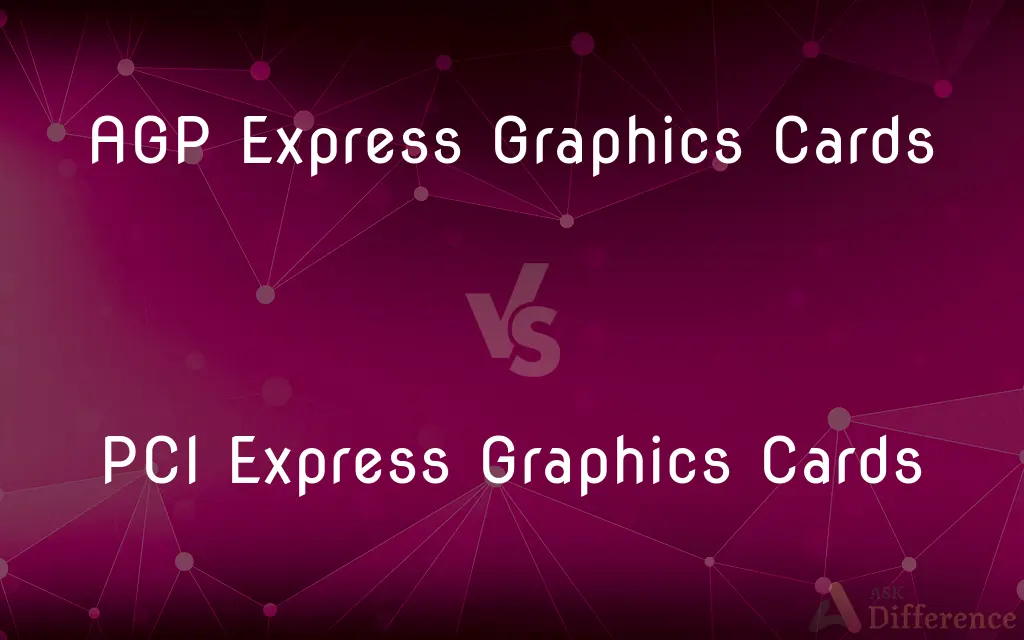AGP Express Graphics Cards vs. PCI Express Graphics Cards — What's the Difference?
Edited by Tayyaba Rehman — By Fiza Rafique — Published on November 10, 2023
AGP (Accelerated Graphics Port) and PCI Express (Peripheral Component Interconnect Express) are both interfaces for connecting graphics cards, with PCI Express being newer and providing faster data transfer rates than AGP.

Difference Between AGP Express Graphics Cards and PCI Express Graphics Cards
Table of Contents
ADVERTISEMENT
Key Differences
AGP Express Graphics Cards, designed for older systems, offer a dedicated pathway between the slot and the processor, primarily focusing on graphics data transfer. PCI Express Graphics Cards are contemporary with the capability to manage more complex graphics data and deliver superior speeds, ensuring smoother visual experiences. Both technologies were developed considering the criticality of graphics data handling but reflect the technological advancements of their respective eras.
AGP Express Graphics Cards use an architecture that is deeply embedded with the objective of intensively supporting graphics. In contrast, PCI Express Graphics Cards demonstrate a versatile architecture, which means they support not only graphics but other data forms as well. Both have their own significant technical structures and data management capabilities that influence their performance in systems.
In the realm of compatibility, AGP Express Graphics Cards are tailored for systems that were manufactured when AGP was the prevalent technology. On the other hand, PCI Express Graphics Cards are built for newer systems, often being incompatible with older motherboards that support only AGP slots. The dichotomy illustrates the evolvement of technologies and their adaptation to contemporary demands.
Discussing potential and scalability, AGP Express Graphics Cards have limitations given their age and technological constraints. PCI Express Graphics Cards, conversely, come with various versions, like PCIe 3.0 and PCIe 4.0, with each successive version enhancing the data transfer speeds and efficiency, offering room for future advancements, which is contrasting to AGP's limited technological forwardness.
In a nutshell, AGP Express Graphics Cards serve as a beacon of the past, reflecting the technological capabilities of their time, while PCI Express Graphics Cards illuminate the progress and enhanced capabilities that have been developed in the graphics technology sector. Both stand as markers on the timeline of computing evolution, embodying the shifting paradigms of data management, speed, and compatibility through the years.
ADVERTISEMENT
Comparison Chart
Technological Era
Older, primarily used in the 1990s
Modern, widely used today
Data Transfer Speed
Slower than PCI Express
Faster and more efficient
Compatibility
Compatible with older motherboards
Not compatible with AGP slots
Scalability and Versions
Limited, no newer versions
Multiple versions available
General Data Management
Focused on graphics data only
Can handle various data types
Compare with Definitions
AGP Express Graphics Cards
AGP Express slots are characterized by a brown color, differentiating them visually from other slots.
Identify AGP Express Graphics Cards slots on the motherboard by their distinctive brown hue.
PCI Express Graphics Cards
PCI Express Graphics Cards are devices that enhance and manage the visual output of a computer using a more modern interface.
Gaming computers often feature powerful PCI Express Graphics Cards to manage high-quality visuals.
AGP Express Graphics Cards
AGP operates through a channel that is exclusively devoted to graphics data transfer.
AGP Express Graphics Cards handle video data through a dedicated pathway to the processor.
PCI Express Graphics Cards
PCI Express comes in several versions, such as PCIe 3.0 and PCIe 4.0, each offering different speeds and capabilities.
Professional graphic designers may opt for PCI Express Graphics Cards with PCIe 4.0 for optimal performance.
AGP Express Graphics Cards
AGP Express was developed to manage 3D graphics data for gaming and 3D rendering.
AGP Express Graphics Cards were once the gold standard for gaming visuals.
PCI Express Graphics Cards
PCI Express is not exclusively limited to graphics data, being versatile in handling various data types.
PCI Express Graphics Cards contribute to overall system performance by efficiently managing various data types.
AGP Express Graphics Cards
AGP Express Graphics Cards are connectors that facilitate graphics data communication between the computer's processor and the display.
Older PCs typically utilize AGP Express Graphics Cards for video output.
PCI Express Graphics Cards
They are the prevalent standard in modern computers due to their enhanced speed and compatibility.
Modern PCs, from workstations to gaming rigs, primarily feature PCI Express Graphics Cards.
AGP Express Graphics Cards
This technology is predominantly seen in computers manufactured during the era of its prevalence.
Many vintage computing enthusiasts might seek AGP Express Graphics Cards for restoration projects.
PCI Express Graphics Cards
They utilize lanes to manage data transfer, with versions having varying lane numbers and speeds.
PCI Express Graphics Cards with more data lanes offer faster and smoother visual experiences.
Common Curiosities
Can AGP Express and PCI Express Graphics Cards be used interchangeably?
No, they cannot be used interchangeably due to different slot designs and technological bases.
Which is faster: AGP Express or PCI Express Graphics Cards?
PCI Express Graphics Cards are faster and more efficient compared to AGP Express.
What are AGP Express Graphics Cards?
These are older graphics card connectors, primarily focused on managing and transferring graphics data.
Why were AGP Express Graphics Cards replaced by PCI Express Graphics Cards?
AGP was replaced due to PCI Express's versatility, speed, and capacity to manage varied data types.
What are PCI Express Graphics Cards?
These are contemporary graphics card connectors, handling varied data types and offering enhanced speeds.
What kind of data is managed by PCI Express Graphics Cards?
PCI Express can manage various data types, not just limited to graphics data.
Can PCI Express Graphics Cards be used in older computers?
Generally not, as older computers might not have the compatible PCI Express slots.
Why do AGP Express Graphics Cards primarily manage graphics data?
AGP Express was specifically designed with a focus on enhancing 3D graphics data management.
Can modern motherboards support AGP Express Graphics Cards?
Typically no, as modern motherboards are designed to support PCI Express slots.
Are PCI Express Graphics Cards still evolving?
Yes, PCI Express technology continues to evolve, with newer versions offering better performance.
Are PCI Express Graphics Cards better for gaming compared to AGP Express?
Yes, PCI Express Graphics Cards usually offer better gaming performance due to enhanced speed and capabilities.
Were AGP Express Graphics Cards ever used in professional graphical work?
Yes, during their era, AGP Express Graphics Cards were used in various graphical works.
Can AGP Express Graphics Cards support modern graphical applications and games?
Generally, no, AGP Express Graphics Cards might struggle with modern graphical demands due to technological limitations.
Why do modern systems prefer PCI Express Graphics Cards?
Due to their enhanced data management, speed, and compatibility with contemporary technologies and demands.
What distinguishes AGP Express slots visually from PCI Express slots?
AGP Express slots are typically brown, while PCI Express slots are not.
Share Your Discovery

Previous Comparison
Google Drive vs. Google Docs
Next Comparison
Already vs. All ReadyAuthor Spotlight
Written by
Fiza RafiqueFiza Rafique is a skilled content writer at AskDifference.com, where she meticulously refines and enhances written pieces. Drawing from her vast editorial expertise, Fiza ensures clarity, accuracy, and precision in every article. Passionate about language, she continually seeks to elevate the quality of content for readers worldwide.
Edited by
Tayyaba RehmanTayyaba Rehman is a distinguished writer, currently serving as a primary contributor to askdifference.com. As a researcher in semantics and etymology, Tayyaba's passion for the complexity of languages and their distinctions has found a perfect home on the platform. Tayyaba delves into the intricacies of language, distinguishing between commonly confused words and phrases, thereby providing clarity for readers worldwide.












































